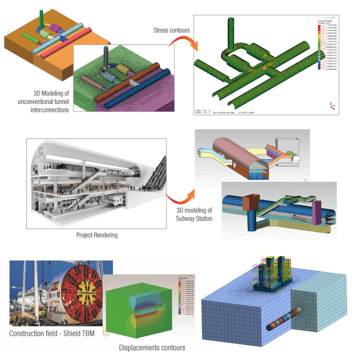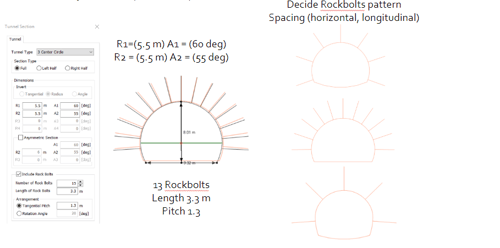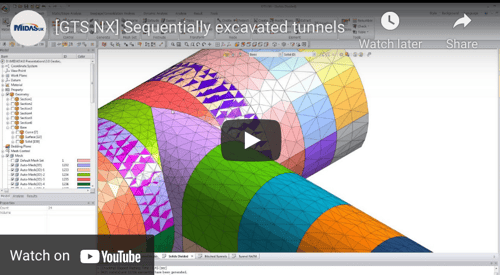Midas GTS NX: Tunneling with a Structural Approach

Author: MIDASoft
Publish Date: 27 Dec, 2021
Tunnel projects are a rather unique challenge. That's because, tunnels to put it loosely (no pun intended), are underground/buried roadways . Therefore, usually when one thinks of tunnels, geotechnical engineers immediately comes to mind because of the soils. However, with the need to verify codes, structural engineers need to check all designs. Therefore it becomes a hybrid project where geotechnical and structural engineers need to be aware of the entirety of the challenges a tunnel poses.

For structural engineers, one of the challenges comes in with setting up the model. To provide a little context, there are usually a combination of construction methods used for tunneling that affects the cost, time, and disruptions. The most common/popular methods are: open cut & cover, sequential excavation (NATM), and tunnel boring (TBM). Each have their distinct advantages depending on the traffic and ground conditions.

The Open Cut and Cover Method is normally the most economical way to build a has a few defects, mainly that it requires the subway to be close to the surface, causing disruptions in local traffic. The Sequential Excavation Method (NATM), the tunnel face is excavated in stages. This method supports elements installed in between excavation stages. This method also uses shotcrete and interlocking frames. Although it is more economical, this method is a bit more time consuming than our last method, Tunnel Boring Machine (TBM). With TBM, the excavation is done with a special machine that digs tube like passages. The machine digs and installs support automatically. Although this method is more expensive than the ones mentioned prior, it is exceptional for long tunnels.
These excavation methods are only some of the many things engineers must consider when designing a tunnel. Other considerations consist of the type and shape of the tunnel, water levels and hydraulic conditions, support systems, ground status, earth pressure coefficient, and many other uncertainties.
During this entire process, there are many ways in which the workload can be divided and designed. Some engineers prefer hand calculations while structural engineers may prefer structural software (2D) which is based on loads, and analyzes lining shape and thickness. While geotechnical engineers may prefer a geotechnical specific software for 2D and 3D analysis and design to consider ground material and excavations patterns and methods. Luckily, there is a platform that allows for both 1D, 2D and 3D analysis for tunnels, midas FEA NX.

As we continue this tunnel series, we will be demonstrating the different methods in addition to Structural Analysis of Tunnels and Geotechnical Analysis of Tunnels. We will touch upon how to design tunnel shape and lining thickness from load demands, how to determine and verify excavation patterns and rock bolt distribution from ground deformation, plasticity and axial forces on bolts. We will also be learning how to determine and verify excavation patterns based on ground displacements, status and safety factors. Ultimately, at the end of this series, with the information and guidance provided you will be able to design and analyze excavations of a tunnel in 3D.

But first, starting the fundamentals, structural analysis gives importance to the uncertainty of loads acting on the structure. We have a 1D tunnel lining tutorial to help grasp the concepts of setting up a model in a structural approach. Get your free FEA NX license and get started on modeling >>



Add a Comment